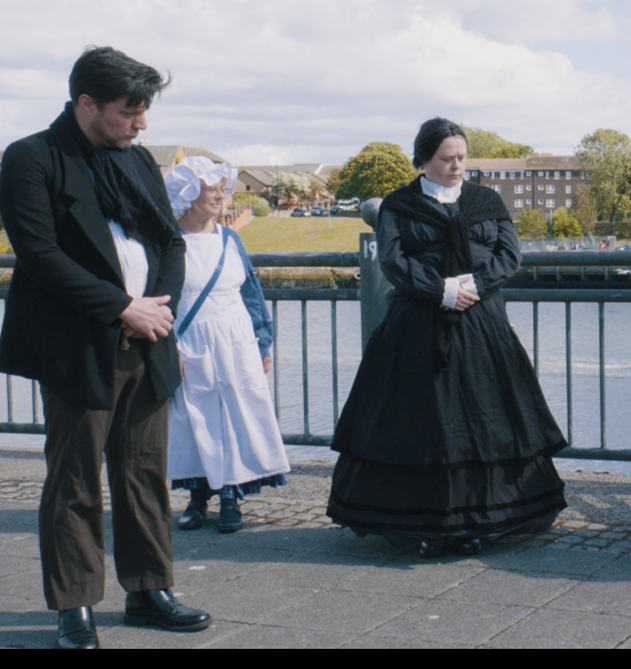“Sunderland’s Peterloo”: Commemorating the 1825 North Sands Massacre
Dr David Gordon Scott

On Sunday, 3rd August, more than 100 people attended the bicentennial event for the 1825 North Sands Massacre. Early in the afternoon, people gathered at St Peter's Church, Sunderland, for a procession to the site of the massacre. 200 years ago on this day, seven people were gunned down by soldiers of the Third Light Dragoons under the authority of magistrate and local ship owner John Davison during a strike by Sunderland Seafarers. Four of the people killed were merely bystanders, indicating the indiscriminate nature of the killings. Referred to as ‘Sunderland’s Peterloo’, the North Sands Massacre was headline news at the time but has been virtually forgotten for generations.
The bicentennial commemorations were opened by the Mayor of Sunderland, Councillor Ehthesham Haque, who introduced this tragic story of a forgotten struggle by ordinary people for a dignified life. In remembering the North Sands massacre, the Mayor said, it was important that we not only commemorate these deaths but also highlight the long-standing spirit of resilience and solidarity that makes the city of Sunderland so special.

Marty Longstaff then performed the song North Sands. Marty had written this song specifically for the commemorations and received a rapturous response from those gathered. The lyrics referred directly to the 1825 events and captured both the reasons for the protest and the terrible injustice wrought upon the people of Sunderland.
His song North Sands is an instant classic and a de facto theme tune for the commemorations. The opening lines of the song were subsequently aired on TV in the BBC Look North coverage broadcast on Sunday evening.
Marty later also played his famous song Shipyards. Once again, performed with great emotion, the lyrics beautifully resonated with the sentiments of remembrance at the commemorations.
Dr Joseph Cozens, a researcher at The National Archives, then provided a detailed historical overview of the 1825 Seamen’s strike. Dr Cozens explained the importance of the coal trade for the shipping industry in Sunderland, but also the problems that the seafarers and their dependents faced regarding poor working conditions, low pay and unemployment. He explained how the sailors’ union, the “Seaman’s Loyal Standard Association”, had been formed, and the specific problems that led to the 1825 strike.

Dr David Gordon Scott then gave details about the events on the 3rd August 1825. Dr Scott explained how the striking sailors had attempted to prevent two coal ships – the Mary and the Busy – from leaving the port. The ship owners enlisted the support of magistrate John Davison and 12 soldiers from the Third Light Dragoons, who then took to the water on a small mail-carrying steamship called the Dorothy and Thomas. The strikers retreated to the North Sands beach, where around 100 people, mainly women and children, had gathered in support of their actions. After stones were thrown, the soldiers opened fire. Within minutes, six people were seriously wounded, and a further seven were either dead or dying. Outraged, the people of Sunderland believed that those who had been killed had been murdered.
Eileen Richardson then performed two songs a cappella: Sailors Strike and Sturdy Sons of the Wear. Both were beautifully sung and with great passion. Eileen was in costume, and her songs epitomised the emotional gravity and intensity of the event and the overriding sense that it was commemorating a great historical injustice.
The National Secretary of the RMT [Railway, Maritime and Transport Union], Darren Proctor, then spoke. In a rousing speech, Darren explained the historical significance of the Seaman’s Loyal Standard Association in the development of seafarers' unions and the important role that Sunderland and its workers had performed in the struggle for decent working conditions. Significantly, he also made a direct connection between the 1825 seamen’s strike and its deadly legal repression and the ongoing struggle for workers' rights and health and safety in the workplace today, thus emphasising the continuing necessity of building a strong public memory of the North Sands Massacre.
Dr Scott then mentioned that the struggles for pay and conditions by the striking seamen in 1825 were a matter of life and death, noting that the great dangers that the seafarers faced at work at that time were greater than even those for miners. He noted that between 1827 and 1829, 107 ships from Sunderland had been lost and that generally the health of seafarers was broken by their mid-30s, with life expectancy in the low 40s.

Jamie Brown and Corinne Kilvington, from Theatre Space North East, then combined a performance of the Seaman's Loyal Standard Song, which had been a popular tune in the 1820s, with a short piece of street Theatre. In their play, a merchant ship captain and a widow from the massacre come together to demand truth, justice and accountability for those who died at the North Sands Massacre. This incredibly powerful performance, which left nobody in the crowd unmoved, beautifully expressed the sense of righteous anger of the people of Sunderland and their belief that their loved ones had been murdered.
Helena Wildish then read the names of the seven people who had been killed: Thomas Aird, Richard Wallace, John Dover, Ralph Hunter Crieghton, James Quigley, Thomas Wilkinson and Mary Wilson. Naming those who died is a key part of any process of remembrance and puts both their lives and deaths back into public memory. The Rev Chris Howsen then held a minute’s silence for those who died. Rev Howson, in his speech, also made clear connections between the struggles of those in the past and those in the present. He connected this commemorative event to those of International Workers Memorial Day, poetically reminding us to ‘remember the dead, and fight for the living.
The final commemorative act was the laying of the wreath. The wreath has been created by Bishopwearmouth Cooperative and was placed by the North Sands Bicentennial Banner, situated directly opposite the Exchange Building Tower, by Dr Scott.
The speeches and performances have received widespread and universal acclaim. The event generated many strong emotions - passion, sadness, righteous anger, and pride. The bicentennial commemorations have placed the tragedy once again into living public memory, but most importantly of all, they have helped in keeping the promise of the people of Sunderland from 200 years ago – that what happened in 1825 should be regarded as the ‘ever to be remembered 3rd August’.
